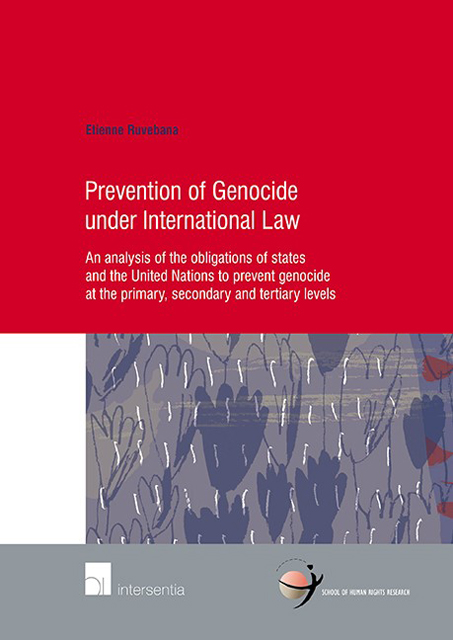 Prevention of Genocide Under International Law
Prevention of Genocide Under International Law Book contents
- Frontmatter
- Acknowledgements
- Contents
- List of Abbreviations
- Chapter I General Introduction
- Chapter II The Concept of Prevention as Understood in various Fields
- Chapter III The Concept of Prevention in the Field of Genocide in General
- Chapter IV Prevention of Genocide Under International Law
- Chapter V The Obligation of Territorial States to Prevent Genocide Under International Law
- Chapter VI Prevention of Genocide by Non-Territorial States Under International Law
- Chapter VII The United Nations and the Obligation to Prevent Genocide Under International Law
- Chapter VIII Prevention of Genocide and the Concept of the Responsibility to Protect
- Chapter IX Summary and General Conclusions
- Bibliography
- Samenvatting
- Curriculum Vitae
- School of Human Rights Research Series
Chapter IV - Prevention of Genocide Under International Law
Published online by Cambridge University Press: 24 November 2022
- Frontmatter
- Acknowledgements
- Contents
- List of Abbreviations
- Chapter I General Introduction
- Chapter II The Concept of Prevention as Understood in various Fields
- Chapter III The Concept of Prevention in the Field of Genocide in General
- Chapter IV Prevention of Genocide Under International Law
- Chapter V The Obligation of Territorial States to Prevent Genocide Under International Law
- Chapter VI Prevention of Genocide by Non-Territorial States Under International Law
- Chapter VII The United Nations and the Obligation to Prevent Genocide Under International Law
- Chapter VIII Prevention of Genocide and the Concept of the Responsibility to Protect
- Chapter IX Summary and General Conclusions
- Bibliography
- Samenvatting
- Curriculum Vitae
- School of Human Rights Research Series
Summary
“Many hope that there will be no more wars, but we dare not to rely on mere hopes for protection against genocidal practices by ruthless conquerors”
Raphael LemkinINTRODUCTION
The previous chapter explained the path to genocide and concluded that the prevention of genocide needs to tackle the different factors and phases that contribute to leading to its perpetration. It was argued that every factor and phase of the process is important and needs measures tailored to it. In so doing, given the nature of the process to genocide, it was argued that prevention must be undertaken at three levels. These are the primary, secondary, and tertiary levels. It was questioned if and how the legal framework for the prevention of genocide needs to be adjusted to these levels. This requires the examination of the existing laws on the prevention of genocide. Therefore, this chapter primarily seeks to show the origin and definition of genocide as well as the process of the adoption of the Genocide Convention in order to understand the context in which this convention was adopted which helps in the understanding of the spirit of the convention as far as the scope of prevention of genocide is concerned. This is important to understand before analysing in deep what the scope of the obligation to prevent genocide entails to its bearers in next chapters. Thus, the present chapter explains in its first section the historical context in which the Genocide Convention was drafted and explained at its initial stage.
Furthermore, this chapter examines the legal status of the obligation to prevent genocide in order to answer the question whether it is a legal obligation on its own or a component of the obligation to punish. It also examines who the bearers of the obligation to prevent genocide are under both the Genocide Convention and customary international law and discusses the temporal scope of the obligation to prevent genocide. Finally, it discusses the ICJ test on knowledge of serious risk of genocide.
ORIGIN AND DEFINITION OF GENOCIDE: A PREVENTION PERSPECTIVE
It is important to show the context in which the laws on genocide came into existence and to see what can be learned from this for the prevention of genocide.
- Type
- Chapter
- Information
- Prevention of Genocide Under International LawAn Analysis of the Obligations of States and the United Nations to Prevent Genocide at the Primary, Secondary and Tertiary Levels, pp. 75 - 112Publisher: IntersentiaPrint publication year: 2014


